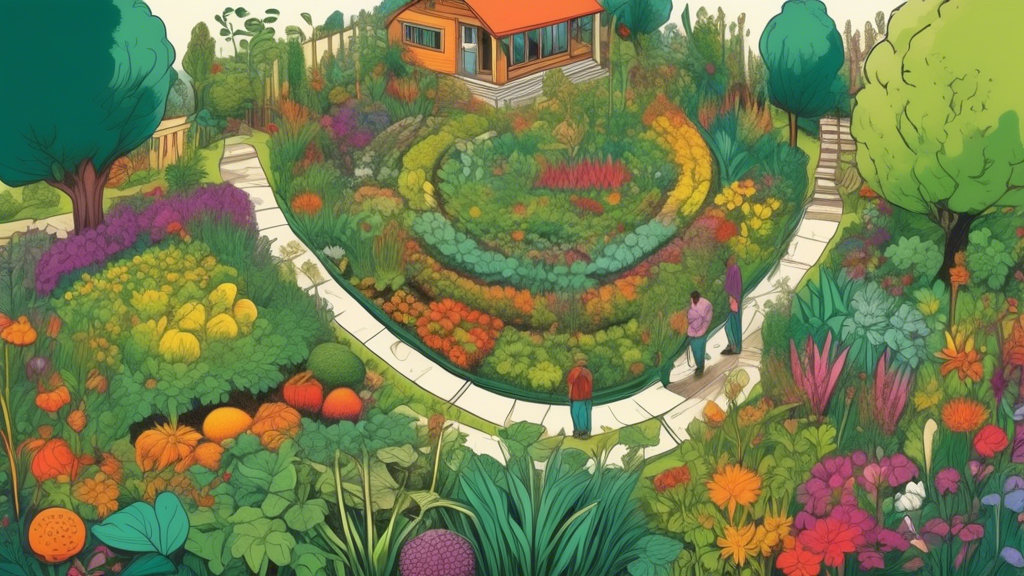In a world grappling with environmental degradation and resource depletion, permaculture emerges as a beacon of hope, offering a holistic and regenerative approach to designing sustainable human settlements. More than just organic gardening or sustainable agriculture, permaculture is a design philosophy that draws inspiration from natural ecosystems to create harmonious and productive environments for both people and the planet.
Understanding the Essence of Permaculture
Permaculture, a portmanteau of permanent agriculture and permanent culture, was coined by Australians Bill Mollison and David Holmgren in the 1970s. It is a multidisciplinary design system grounded in ethics, principles, and practices that guide the creation of self-sustaining and resilient ecosystems. Permaculture transcends geographical boundaries and can be applied to diverse contexts, from urban balconies to rural homesteads.
The Three Ethics of Permaculture
At the heart of permaculture lie three fundamental ethics that serve as guiding principles for all decisions and actions:
- Care for Earth: This ethic emphasizes the interconnectedness of all living things and the responsibility to protect and regenerate the Earth’s ecosystems. It encourages practices that restore soil health, conserve water, and promote biodiversity.
- Care for People: Recognizing that human well-being is inseparable from a healthy planet, this ethic prioritizes meeting basic human needs such as food, water, shelter, and community in a just and equitable manner.
- Fair Share: This ethic acknowledges the limits to growth and encourages the equitable distribution of resources. It emphasizes sharing surplus, consuming responsibly, and designing systems that prioritize long-term sustainability over short-term gains.
Twelve Principles for Designing Sustainable Systems
To translate these ethics into tangible actions, permaculture employs twelve design principles that provide a framework for creating integrated and resilient systems:
- Observe and Interact: Take time to understand the natural patterns, rhythms, and characteristics of your site before intervening. Patience and careful observation are key to designing effective and harmonious systems.
- Catch and Store Energy: Develop strategies to capture and store energy, whether it’s sunlight, rainwater, or wind, to build resilience and reduce dependence on external inputs.
- Obtain a Yield: Ensure that your designs are productive and provide tangible yields, such as food, fuel, or other valuable resources, to meet your needs and create abundance.
- Apply Self-Regulation and Accept Feedback: Encourage self-regulating systems that minimize the need for external interventions. Observe feedback loops and make adjustments as needed to maintain balance and resilience.
- Use and Value Renewable Resources and Services: Prioritize the use of renewable resources, such as solar energy and rainwater harvesting, to create sustainable and regenerative systems.
- Produce No Waste: Embrace a circular economy by minimizing waste and transforming byproducts into valuable resources. Compost organic matter, reuse materials, and close nutrient loops.
- Design From Patterns to Details: Observe patterns in nature and use them as inspiration for designing efficient and harmonious systems. Consider the bigger picture before focusing on the details.
- Integrate Rather Than Segregate: Foster beneficial relationships between elements in your design to enhance biodiversity, improve soil health, and create a more resilient system.
- Use Small and Slow Solutions: Start with small-scale, manageable solutions that can be gradually expanded upon. Slow and steady progress is often more sustainable and adaptable.
- Use and Value Diversity: Embrace diversity in all its forms to enhance resilience, productivity, and beauty. Polycultures, guilds, and companion planting are key strategies.
- Use Edges and Value the Marginal: Recognize the value of edges and transitional zones, where diversity and interactions are often richest. Maximize edge effects to enhance productivity and biodiversity.
- Creatively Use and Respond to Change: Embrace change as an inherent part of nature and design systems that are adaptable and resilient in the face of disturbances.
Key Practices in Permaculture
Permaculture encompasses a wide range of practical applications, including:
1. Water Harvesting and Management
Effective water management is crucial for sustainable living. Permaculture techniques such as swales, rain gardens, and greywater systems capture, store, and infiltrate rainwater to replenish groundwater, irrigate gardens, and reduce reliance on municipal water sources.
2. Soil Conservation and Regeneration
Healthy soil is the foundation of a thriving ecosystem. Permaculture emphasizes building soil fertility through composting, mulching, cover cropping, and no-till practices, promoting microbial activity, and improving water retention.
3. Food Forests and Edible Landscapes
Permaculture encourages the creation of food forests, which mimic the structure and function of natural ecosystems to provide an abundance of fruits, nuts, vegetables, and herbs. Edible landscaping integrates food-producing plants into ornamental gardens.
4. Natural Building
Permaculture promotes the use of natural and sustainable building materials, such as straw bales, cob, and bamboo, to create energy-efficient, non-toxic, and aesthetically pleasing structures that integrate seamlessly with their surroundings.
5. Renewable Energy
Harnessing renewable energy sources like solar, wind, and micro-hydro power is integral to permaculture. These systems reduce reliance on fossil fuels and contribute to a more sustainable energy future.
Benefits of Permaculture
Embracing permaculture offers a myriad of benefits, including:
- Increased Food Security and Sovereignty
- Enhanced Biodiversity and Ecosystem Health
- Reduced Environmental Impact
- Greater Resource Independence
- Improved Water Conservation and Quality
- Enhanced Community Resilience
Conclusion
Permaculture presents a transformative framework for designing sustainable and regenerative human settlements. By adhering to its ethics, principles, and practices, we can create harmonious and productive environments that nurture both people and the planet. As we face the challenges of a changing world, permaculture offers a path toward a more resilient, equitable, and sustainable future.


